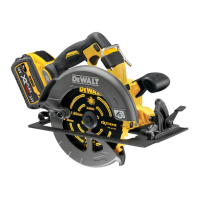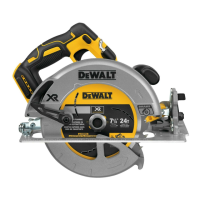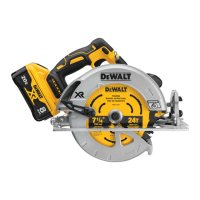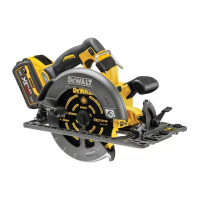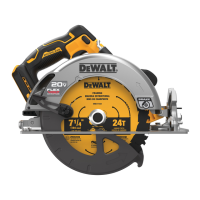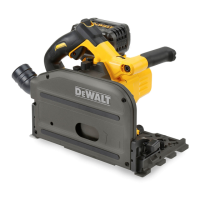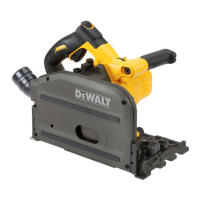ESPAÑOL
22
reducen el riesgo de encender la herramienta eléctrica en
formaaccidental.
d ) Guarde la herramienta eléctrica que no esté en
uso fuera del alcance de los niños y no permita que
otras personas no familiarizadas con ella o con estas
instrucciones operen la herramienta. Las herramientas
eléctricas son peligrosas si son operadas por usuarios
nocapacitados.
e ) Dé mantenimiento a las herramientas eléctricas y
accesorios. Revise que no haya piezas en movimiento
mal alineadas o trabadas, piezas rotas o cualquier otra
situación que pueda afectar el funcionamiento de la
herramienta eléctrica. Si encuentra daños, haga reparar
la herramienta eléctrica antes de utilizarla. Se producen
muchos accidentes a causa de las herramientas eléctricas que
carecen de un mantenimientoadecuado.
f ) Mantenga las herramientas de corte afiladas y
limpias. Las herramientas de corte con mantenimiento
adecuado y con los bordes de corte afilados son menos
propensas a trabarse y son más fáciles decontrolar.
g ) Utilice la herramienta eléctrica, los accesorios y las
brocas de la herramienta, etc. de acuerdo con estas
instrucciones y teniendo en cuenta las condiciones
de trabajo y el trabajo que debe realizarse. El uso de
la herramienta eléctrica para operaciones diferentes de
aquéllas para las que fue diseñada podría originar una
situaciónpeligrosa.
h ) Mantenga las manijas y superficies de sujeción
secas, limpias y libres de aceite y grasa. Las manijas y
superficies de sujeción resbalosas no permiten el manejo y
control seguros de la herramienta en situacionesinesperadas.
5) Uso y Mantenimiento de la Herramienta
con Baterías
a ) Recargue solamente con el cargador especificado
por el fabricante. Un cargador adecuado para un tipo de
paquete de baterías puede originar riesgo de incendio si se
utiliza con otro paquete debaterías.
b ) Utilice herramientas eléctricas sólo con paquetes de
baterías específicamente diseñados. El uso de cualquier
otro paquete de baterías puede producir riesgo de incendio
ylesiones.
c ) Cuando no utilice el paquete de baterías,
manténgalo lejos de otros objetos metálicos como
sujetapapeles, monedas, llaves, clavos, tornillos u otros
objetos metálicos pequeños que puedan realizar una
conexión desde un terminal al otro. Los cortocircuitos en
los terminales de la batería pueden provocar quemaduras
oincendio.
d ) En condiciones abusivas, el líquido puede ser
expulsado de la batería. Evite su contacto. Si entra en
contacto accidentalmente, enjuague con agua. Si el
líquido entra en contacto con los ojos, busque atención
médica. El líquido expulsado de la batería puede provocar
irritación oquemaduras.
e ) No use un paquete de batería o herramienta que
estén dañados o modificados. Las baterías dañadas
o modificadas pueden presentar un comportamiento
impredecible que resulte en incendios, explosión o riesgo de
lesiones.
f ) No exponga un paquete de batería o una
herramienta a fuego o temperatura excesiva. La
exposición a fuego o temperaturas mayores a 130 °C (265 °F)
pueden causar una explosión.
g ) Siga todas las instrucciones de carga y no cargue
el paquete de batería o la herramienta fuera del rango
de temperatura especificado en las instrucciones.
Cargar inadecuadamente o en una temperatura fuera del
rango de temperatura especificado puede dañar la batería e
incrementar el riesgo de incendio.
6) Mantenimiento
a ) Solicite a una persona calificada en reparaciones
que realice el mantenimiento de su herramienta
eléctrica y que sólo utilice piezas de repuesto idénticas.
Esto garantizará la seguridad de la herramientaeléctrica.
b ) Nunca dé servicio a paquetes de batería dañados. El
servicio de paquetes de batería sólo debe ser realizado por el
fabricante o proveedores de servicioautorizados.
Instrucciones de Seguridad para Todas las Sierras
a ) PELIGRO: Mantenga las manos alejadas del área
y de la hoja de corte. Mantenga la otra mano en el
mango auxiliar o en la caja del motor. Si ambas manos
están sujetando la sierra, entonces no podrán ser cortadas
por lasierra.
b ) No ponga las manos debajo de la pieza de trabajo.
El protector no puede protegerle de la hoja debajo de la pieza
detrabajo.
c ) Ajuste la profundidad de corte al grosor de la pieza
de trabajo. Menos de un diente completo de los dientes de la
hoja debe ser visible debajo de la pieza detrabajo.
d ) Ne jamais tenir la pièce à travailler dans vos mains
entre vos jambes pendant que vous coupez. Sujete
firmemente la pieza de trabajo a una plataforma
estable. Es importante soportar apropiadamente la pieza de
trabajo para minimizar la exposición del cuerpo, el atasco de
la hoja o la pérdida decontrol.
e ) Sostenga la herramienta eléctrica solo por las
superficies de agarre aisladas al realizar una operación
en que la herramienta de corte pueda entrar en
contacto con cables ocultos o con su propio cable. El
contacto con un cable vivo puede cargar las partes metálicas
expuestas de la herramienta eléctrica y producir una descarga
eléctrica aloperador.
f ) Cuando corte al hilo, utilice siempre un tope-guía
para cortar al hilo o una guía de borde recto. Esto mejora
la precisión del corte y reduce las probabilidades de que la
hoja seatasque.
g ) Utilice siempre hojas que tengan el tamaño correcto
y la forma correcta (de diamante frente a redonda) de
agujeros para el eje portaherramienta. Las hojas que no
coincidan con los herrajes de montaje de la sierra funcionarán
excéntricamente, causando pérdida decontrol.
h ) No use nunca arandelas de hoja o un perno de hoja
que estén dañados o sean incorrectos. Las arandelas y el
perno de la hoja se diseñaron especialmente para su sierra,
con el fin de lograr un rendimiento óptimo y una seguridad
óptima defuncionamiento.
Instrucciones de Seguridad Adicionales para Todas
las Sierras
Causas del Rebote y Advertencias
Relacionadas
ʵ El retroceso es una reacción repentina a una hoja de sierra
pellizcada, atascada o desalineada, que hace que una sierra
descontrolada se levante y se salga de la pieza de trabajo,
hacia eloperador.

